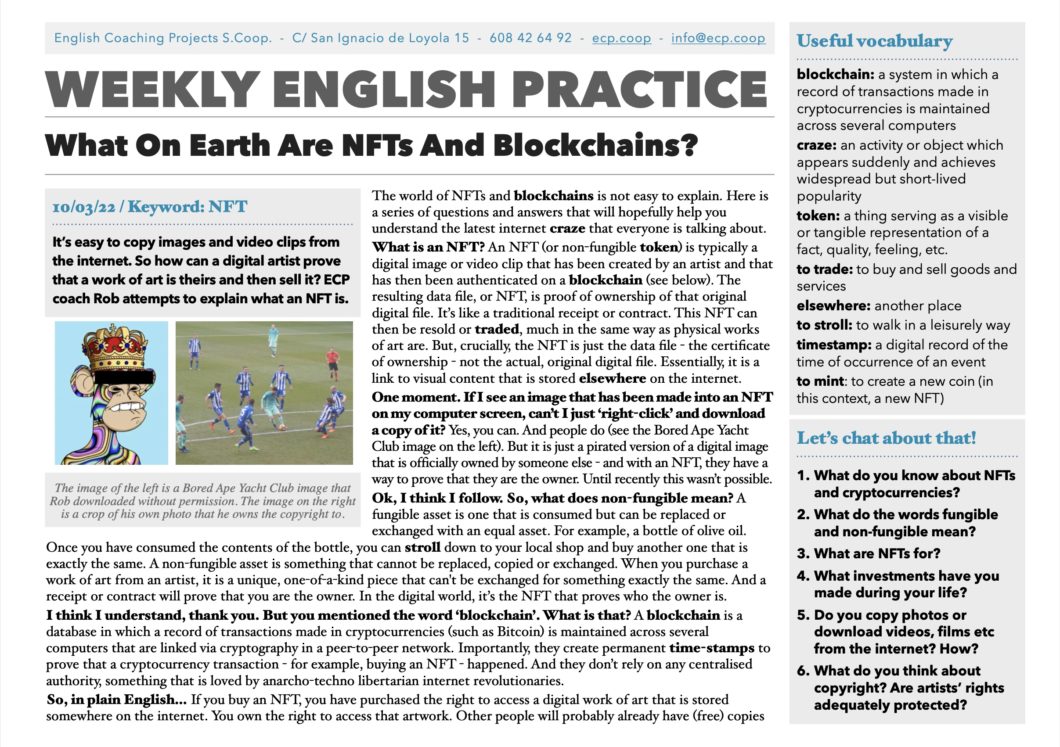What On Earth Are NFTs And Blockchains?
10/03/22 / Keyword: NFTs
It’s easy to copy images and video clips from the internet. So how can a digital artist prove that a work of art is theirs and then sell it? ECP coach Rob attempts to explain what an NFT is.
Click HERE to download the Weekly English Practice as a PDF.
Useful vocabulary
blockchain: a system in which a record of transactions made in cryptocurrencies is maintained across several computers
craze: an activity or object which appears suddenly and achieves widespread but short-lived popularity
token: a thing serving as a visible or tangible representation of a fact, quality, feeling, etc.
to trade: to buy and sell goods and services
elsewhere: another place
to stroll: to walk in a leisurely way
timestamp: a digital record of the time of occurrence of an event
to mint: to create a new coin (in this context, a new NFT)
Listen to the audio and read the text.
It’s easy to copy images and video clips from the internet. So how can a digital artist prove that a work of art is theirs and then sell it? ECP coach Rob attempts to explain what an NFT is.
The world of NFTs and blockchains is not easy to explain. Here is a series of questions and answers that will hopefully help you understand the latest internet craze that everyone is talking about.
What is an NFT? An NFT (or non-fungible token) is typically a digital image or video clip that has been created by an artist and that has then been authenticated on a blockchain (see below). The resulting data file, or NFT, is proof of ownership of that original digital file. It’s like a traditional receipt or contract. This NFT can then be resold or traded, much in the same way as physical works of art are. But, crucially, the NFT is just the data file – the certificate of ownership – not the actual, original digital file. Essentially, it is a link to visual content that is stored elsewhere on the internet.
One moment. If I see an image that has been made into an NFT on my computer screen, can’t I just ‘right-click’ and download a copy of it? Yes, you can. And people do (see the Bored Ape Yacht Club image on the left). But it is just a pirated version of a digital image that is officially owned by someone else – and with an NFT, they have a way to prove that they are the owner. Until recently this wasn’t possible.
Ok, I think I follow. So, what does non-fungible mean? A fungible asset is one that is consumed but can be replaced or exchanged with an equal asset. For example, a bottle of olive oil. Once you have consumed the contents of the bottle, you can stroll down to your local shop and buy another one that is exactly the same. A non-fungible asset is something that cannot be replaced, copied or exchanged. When you purchase a work of art from an artist, it is a unique, one-of-a-kind piece that can’t be exchanged for something exactly the same. And a receipt or contract will prove that you are the owner. In the digital world, it’s the NFT that proves who the owner is.
I think I understand, thank you. But you mentioned the word ‘blockchain’. What is that? A blockchain is a database in which a record of transactions made in cryptocurrencies (such as Bitcoin) is maintained across several computers that are linked via cryptography in a peer-to-peer network. Importantly, they create permanent time-stampsto prove that a cryptocurrency transaction – for example, buying an NFT – happened. And they don’t rely on any centralised authority, something that is loved by anarcho-techno libertarian internet revolutionaries.
So, in plain English… If you buy an NFT, you have purchased the right to access a digital work of art that is stored somewhere on the internet. You own the right to access that artwork. Other people will probably already have (free) copies of the same artwork, but you officially own access to the original, authentic image. Normally though, you don’t own the copyright to it.
Can anyone make, and sell, an NFT? Yes. A few years ago, at a game in Mendizorrotza, I took an incredible – and certainly unique – photograph of FC Barcelona’s Lionel Messi surrounded by all 11 players of Deportivo Alavés. I could mint an NFT of that picture and sell it to you. You would have bought the right to access that photograph on your devices but I can retain the copyright of the original image if I want to and make even more money from my photo by, for example, selling prints or making t-shirts. The problem is that I have absolutely no idea how to mint an NFT…
What happens if the platform where you store the original image disappears? Does my access disappear too? Er, yes. Probably. Nobody really knows how to answer that question, as currently all of this is unregulated.
So what’s the point of NFTs? Digital artists can assert ownership of their artwork and then sell it. The new owner can trade their investment in the same way that art collectors do now at auctions and on specialised markets.
These tokens can also be used to grant access to exclusive services. The Bored Ape Yacht Club NFT project states: “When you buy a Bored Ape NFT, you’re not simply buying a provably rare piece of art. You’re gaining membership access to a club whose benefits and offerings will increase over time. It can serve as your digital identity, and open digital doors for you.”
I’m not sure I’ve understood any of this. Me neither! So, do you want to buy an NFT of my amazing photo of Lionel Messi? It includes the right to have lunch with me once a year…
Written by ECP coach Rob Hextall
Let’s chat about NFTs!
- What do you know about NFTs and cryptocurrencies?
- What do the words fungible and non-fungible mean?
- What are NFTs for?
- What investments have you made during your life?
- Do you copy photos or download videos, films etc from the internet? How?
- What do you think about copyright? Are artists’ rights adequately protected?
Take a moment to look at these related articles!
Could our digital records disappear in a disaster or an attack?
Communication Revolutions: From the Telegraph to the Internet of Things

